Primate research in southern Mexico Alejandro Estrada Ph.D Laboratory of Primatology, Estación de Biología "Los Tuxtlas", Instituto de Biología Universidad Nacional Autónoma de México
|
General background |

In Latin América, as in the rest of the world, tropical rain forests have been subjected, in the last 50 years, to a rapid process of destruction and fragmentation resulting from land management practices in conflict with a rational use of the resources present in these forests. Coupled to these events, the accelareted growth of human populations and the pressing demand for space and food also contribute to the rapid disappearance of these ecosyustems in the American continent.
The geographic distribution of tropical rain forests in Mexico encompassed basically the south-eastern states of the country, including those in the Yucatan peninsula. Originally it covered an area of roughly 110,000 square kilómeters or about 6 % of the land surface of the country.

Original distribution (upper map) of the tropical rain forest in Mexico. The lower map shows the estimated current distribution or about 10-20% of 110,000 km square.
The rapid growth of the human population and the intensification of cattle ranching and of agricultural and industrial activities have, in the last 50 years, converted about 80% of the original rain forests to man made vegetation. The ramaining forests of southern Mexico continue to be transformed by human activity at variable, but high rates. For example, in Los Tuxtlas, Veracruz, annual deforestation rates are 4.3%, in north-eastern Chiapas 12.4%, in central Chiapas bordering with Guatemala 4.5% and in the southern part of the Yucatán the annaul rates are 7.7%.
The high rates of conversion of tropical rain forests to simplified agrosystems have resulted in the massive local and regional extinction of many plant and animal species, including the three primate species that exist in southern Mexico.
An important component of the high biological diversity of the tropical rain forest of southern Mexico, is a broad spectrum of mammal species. Among these, three species of primates stand out as a result of their size and behavior.
Two of these are commonly known as howler monkeys and they are members of the genus Alouatta, represented by two species: palliata y pigra. The third species is the Spider monkey, scientifically known as Ateles geoffroyi..

The upper map shows the original distribution of Alouatta palliata and Ateles geoffroyi (both stripped and black areas). The original distribution of A. pigra, only encompassed the black area. The lower map shows the current distribution of the three species. The original geographical distribution of the three species closely matched the original distribution of tropical rain forests in southern Mexico.
General aspects of the Natural History of Howler Monkeys
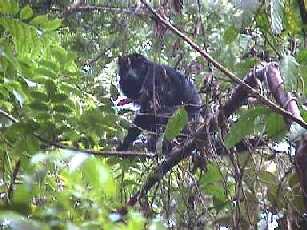
| Howler monkeys are diurnal
mammals with a prehensile tail. They are arboreal
and feed on plant parts such as leaves and fruit.
They live in permanent social groups termed
"troops". Troops move daily searching
for food within a restricted area known as home
range. Howler monkeys feed on leaves, fruits and flowers of trees of different species, but they are usually selective about the tree species they exploit. Such selectivity drives their daily movements. Leaves and fruit are the principal item in their diet, but young leaves and mature fruits are their principal source of proteín and carbohydrates. |
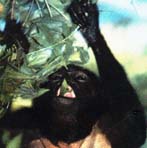 |
 |
The male howlers produce the
howls that make them popular and from which these
monkeys derive their common name. This behavior
works as a spacing mechanism between troops,
avoiding direct confrontations to secure a
monopoly over the resources found within their
home range.
|
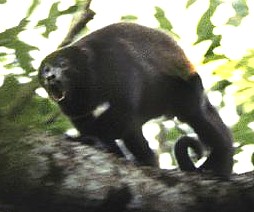 |
The howler monkeys of southern México |
In the case of the howler monkeys, the species A. palliata has a broad geographic distribution ranging from southern Mexico to the rest of Central America. The northernmost representatives of the species are found in Los Tuxtlas, southern Veracruz. In contrast, the species A. pigra, the Black Howler Monkey, has a restricted geographic distribution in southern Mexico.
| A. pigra is found only in the states of Tabasco, Campeche, northeastern Chiapas and in the Yucatan peninsula. The species is also present in the Guatemalan Peten and in Belize. Such restricted geographical distribution points out to the endemic nature of this species in the Mesoamerican region. |
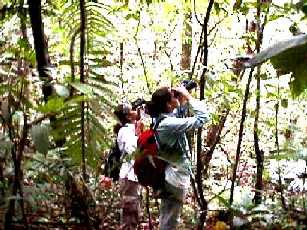
| The two species of howler
monkey present in Mexico, Alouatta
palliata and Alouatta
pigra, differ
in appearance. A. palliata has brown pelage with
a yellowish color on the sides of the trunk. Some
individuals display patches of blonde hair in
different parts of the body such as the tail,
base of the back and patches of variable light
and dark pigmentation in hands and feet (see the
image to the right). In contrast, A. pigra es totally black and does not display the variations in fur color indicated for A. palliata. The black howler monkey, A. pigra, is slightly heavier than A. palliata, with an average weight of 8-10 kg, while the latter species dispalys an average weight of 6-8 kg. There are also important differences in the vocal reppertoire of both species and probably in their social and reproductive behaviors, but these have not been documented thoroughly. However, both species share general behavior patterns such as the howling as a territorial mechanism, life in permanent social groups, and a herbivorous diet. |
|
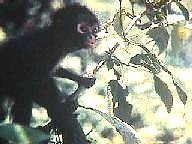 |
Spider Monkeys (Ateles geoffroyi) |
| Spider
monkeys are diurnal and arboreal. They live in
permanent social groups and move through the
forest canopy swinging from arms and the
prehensile tail. Mature fruits constitute the
principal component of their daily diet, a reason
why they travel great distances daily in their
search. Mexico harbors the northernmost distribution of the genus Ateles in the Neotropics. The Spider monkeys existing in southern Mexico are represented by two subspecies: Ateles geoffroyi vellerosus, Distributed from southern Tamaulipas to the border with Guatemala, and Ateles geoffroyi yucatanensis, restricted to the Yucatan peninsula. As in the case of Alouatta, the geographical distribution of spider monkeys in Mexico is closely associated to the distribution of tropical wet forests. The disappearance of these ecosystems as a result of human activity has resulted in the local disappearance of populations of spider monkeys in southern Mexico. |
|
| In contrast to the small home ranges of howler monkeys (a few dozen hectares), spider monkey troops of equivalent size require about 500 ha to sustain themselves through the year. These differences are the result, on one hand, of the capacity of howler monkeys to use a food resource that is predictable in space and time: leaves. Spider monkeys in contrast exploit a very ephemeral resource that creates higher ranging areas. Such situation, enhances the fragility and sensitivity of spider monkeys to habitat destruction, fragmentation and isolation by man. Coupled to such high sensitivity to habitat loss and degradation intensive hunting of spider monkeys to commercialize the meat and the illegal trafficking of infants as pet has resulted in the extensive local extinction of these primates in southern Mexico. |
| Our data banks about the current location, size and demographic structure of spider monkey populations in southern Mexico is practically non existent. Similarly, information of basic aspects of their ecology and behavior is very scanty. We need to direct efforts in the field to update the above information and to develop conservation scenarios that will protect populations representative, in the various states of southern Mexico, of both spider monkey subspecies. |

